 Archive for August, 2007
Archive for August, 2007
Mario Gilbert’s 2007 Tundra DoubleCab
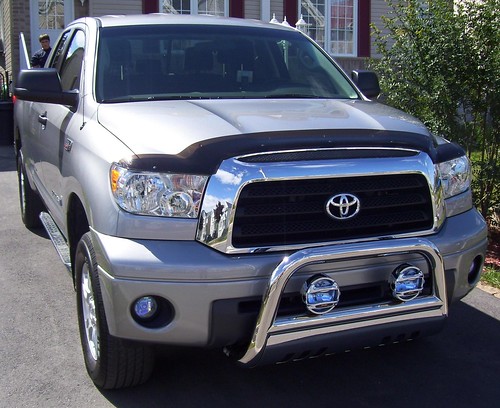
We got an email from Mario asking us if we would be interested in putting pictures of his 2007 up on the blog. Our answer — of course! Mario has added a few things to his truck. For starters he’s put on a nice chrome bull bar. He’s also got a Ready Lift leveling kit and he’s replaced the stock fog light bulbs with bulbs that have a blue tint. Tinted windows, side steps, a bug shield, and a 4×4 logo round out the mods.
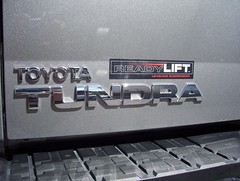
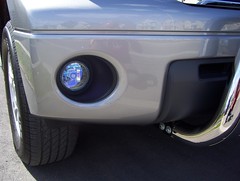


Inside, Mario has a Garmin GPS and a powered sub (not shown). Mario plans to add a MagnaFlow dual exhaust, bigger tires, and a Lear 100XQ topper.
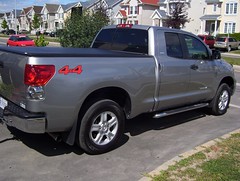

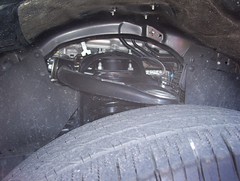
Mario, thank you for sending in these pics. You’ve got a nice looking truck and you’re off to a great start with your mods.
If you want to see your truck on TundraHeadquarters, just contact us! We’re always interested in putting up photos of reader’s rides!
New US Army Diesel Hybrid: Fast, Quiet, Gas $aver
Here’s a trivia fact: the U.S. Army 1st Armored Division uses approximately 600,000 gallons of fuel.
A day.
That’s enough fuel to fill-up all the Tundra’s sold in June 07′. It’s enough fuel to coat a standard football field in 17 inches of fuel (trying running a sweep in that mess). It’s also enough fuel to drive your new Tundra for the next 720 years.
In other words, it’s a lot. Too much if you ask the US Army. Considering that 70% of what the Army hauls to the battlefield is fuel (not ammo, not food, but fuel), any opportunities to reduce fuel consumption are investigated seriously. That’s why the Army gave Quantum Technologies of Irvine, CA a $4.88 million contract to develop this prototype:

Just kidding — that’s the Warthog from Halo. Here’s the REAL prototype:

You can see how we might get the two confused.
The prototype, known as the U.S. Army Alternative Mobility Vehicle (AMV) Aggressor, is powered by a battery pack that is charged by a yet-to-be-determined diesel. While the main benefit of having a battlefield hybrid is fuel savings, the Aggressor also has a “silent” battery-only mode that allows the vehicle to move with little or no noise. Unlike most consumer hybrids, the Aggressor is fast. O-40 in about 4 seconds. We know — it’s not as fast as a new Tundra — but it’s not bad. Besides, does your Tundra have a S.A.W. attached to it?
What does this mean for us? A few things.
1. When the military develops a battlefield diesel hybrid, we’re all that much closer to seeing one parked in our own driveways.
2. Hybrid technology is powerful and durable enough to be considered for a vehicle used in combat. That means the whole “hybrid” thing is probably here to stay.
3. Toyota currently produces a diesel hybrid for sale in Japan and Australia. It’s called the Hino Dutro Hybrid. Coincidence? Definitely. But it’s easy to imagine a diesel hybrid Tundra someday soon.
Writers Needed
Do you enjoy reading the blog here at Tundra Headquarters? Would you like to contribute?
We’re looking for stories between 400 and 800 words from new Tundra owners. Write about whatever you’d like — as long as it’s related to your truck. Send us your story about taking your Tundra camping. Send us a “how-to” for properly detailing the truck. Tell us why the dealership you bought your truck from is good (or bad).
Just make sure the story is original and “G” rated (this is a family site).
For every story we publish, we’ll send the owner a fancy new TundraHeadquarters.com T-Shirt!
Check out WileETundra’s Online Modification Guide
Opus.
Awesome.
Jealous.
Those are the words that sum up our feelings towards WileETundra’s Online Modification Guide. Not only is it a huge task, but it’s an awesome compilation of information and it’s made us very jealous — we wish we would have thought of it first.
Bravo WileE, and keep em’ coming. We love reading about your mods.
Is Your New Tundra Getting The EPA Rated Gas Mileage?
We recently received an email from a new Tundra owner who wasn’t getting the mileage stated on the sticker. Basically, this person said that “I drive mostly on the highway, but I’m not getting the 18 mpg listed on the sticker. Instead, I’m getting about 15.5 mpg.”
We haven’t heard back from this person yet, but we sent them an email with the following ideas. We figured it might be useful to someone else so we copied it here…
1) Calculate the mileage manually — sometimes the automatic system is inaccurate. We’ve found that minutes spent idling at the dealership (before you owned it) will throw the computer-calculated mileage off substantially, especially for the first few tanks of gas.
2) New engines need at least 1k miles to break-in properly, but it may take as much as 5k miles before you get the best mileage.
3) Have you added any aftermarket wheels or tires, or maybe a camper or other high profile item to your truck? Any of these things could be hurting your mileage. Surprisingly, even a set of tires can drop 1 or 2 mpg if they have aggressive tread.
4) The engine control module (ECM) adapts to the driver’s style to provide the best performance and fuel economy. If you have another driver in the family, their style could be drastically different. Even if this other driver isn’t “hot rodding” the truck, the drastic difference can trick the ECM to switch into “programming” mode every time you switch drivers. I can’t imagine this would result in such a big difference between EPA and actual, but it is possible.
5) How much of your driving is on the highway? Even if you drive 90% of the time on the highway, the other 10% of the time you drive in the city can lower your overall mileage as much as 1 mpg.
6) Finally, if none of the above seem plausible, your truck may be one of a few Tundras that simply doesn’t achieve the stated mileage. Just like some trucks do better than the sticker, some trucks do worse. Your dealer can try to fix this be re-flashing the ECM, or maybe updating the truck’s software. Either of these will fix the problem.

